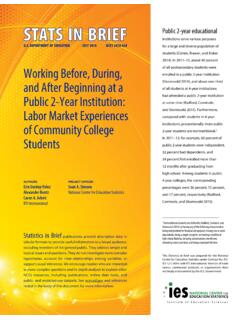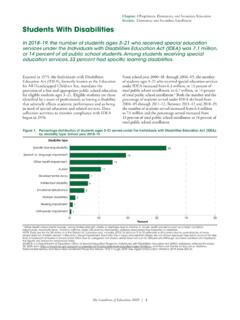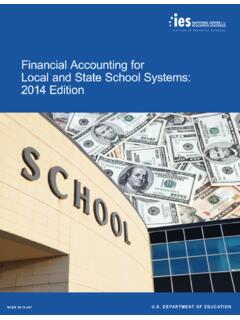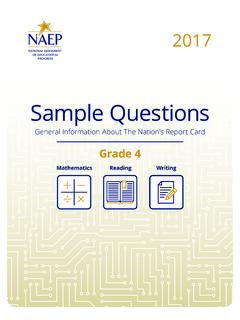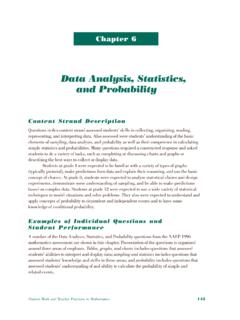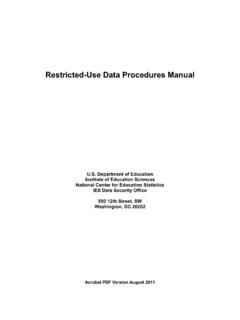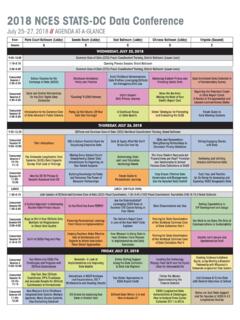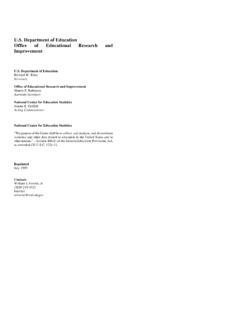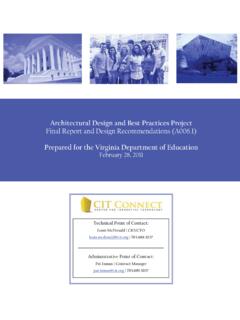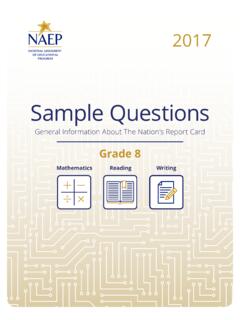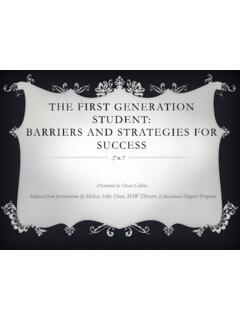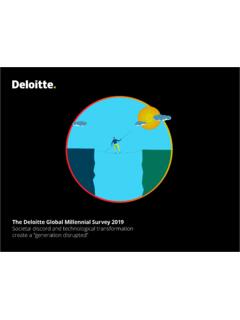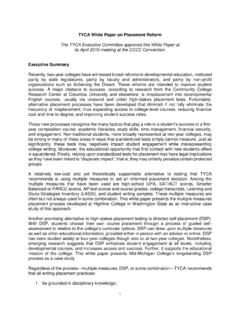Transcription of Education in Postsecondary First-Generation Students
1 Department of Education Institute of Education Sciences NCES 2005 171 First-Generation Students in Postsecondary Education A Look at Their College Transcripts Postsecondary Education Descriptive Analysis Report THIS PAGE INTENTIONALLY LEFT BLANK Department of Education Institute of Education Sciences NCES 2005 171 First-Generation Students in Postsecondary Education A Look at Their College Transcripts Postsecondary Education Descriptive Analysis Report July 2005 Xianglei Chen MPR Associates, Inc. C. Dennis Carroll Project Officer National Center for Education Statistics of Education Margaret Spellings Secretary Institute of Education Sciences Grover J.
2 Whitehurst Director National Center for Education Statistics Grover J. Whitehurst Acting Commissioner The National Center for Education Statistics (NCES) is the primary federal entity for collecting, analyzing, and reporting data related to Education in the United States and other nations. It fulfills a congressional mandate to collect, collate, analyze, and report full and complete statistics on the condition of Education in the United States; conduct and publish reports and specialized analyses of the meaning and significance of such statistics; assist state and local Education agencies in improving their statistical systems; and review and report on Education activities in foreign countries.
3 NCES activities are designed to address high priority Education data needs; provide consistent, reliable, complete, and accurate indicators of Education status and trends; and report timely, useful, and high quality data to the Department of Education , the Congress, the states, other Education policymakers, practitioners, data users, and the general public. We strive to make our products available in a variety of formats and in language that is appropriate to a variety of audiences. You, as our customer, are the best judge of our success in communicating information effectively.
4 If you have any comments or suggestions about this or any other NCES product or report, we would like to hear from you. Please direct your comments to: National Center for Education Statistics Institute of Education Sciences of Education 1990 K Street NW Washington, DC 20006-5651 July 2005 The NCES World Wide Web Home Page The NCES World Wide Web Electronic Catalog is Suggested Citation Chen, X. (2005). first generation Students in Postsecondary Education : A Look at Their College Transcripts (NCES 2005 171). Department of Education , National Center for Education Statistics.
5 Washington, DC: Government Printing Office. For ordering information on this report, write of Education ED Pubs Box 1398 Jessup, MD 20794-1398 or call toll free 1-877-4ED-PUBS Content Contact: Aurora D Amico (202) 502-7334 Executive Summary Recent research has generated a large body of knowledge about Students who are the first members of their families to attend college (referred to as First-Generation Students in this report).
6 1 The results show that such Students are at a distinct disadvantage in gaining access to Postsecondary Education . Even those who overcome the barriers and do enroll have difficulty remaining enrolled and attaining a degree (Horn and Nu ez 2000; Nu ez and Cuccaro-Alamin 1998; Warburton, Bugarin, and Nu ez 2001). What has not been well studied, however, are the coursetaking experiences of First-Generation Students after entering college. What do First-Generation Students study in college? How well do they do in their coursework? Is their coursework different from that of their peers whose parents went to college?
7 This report explores these questions by using data from the Postsecondary Education Transcript Study (PETS) of the National Education Longitudinal Study of 1988 (NELS:88) to examine the majors and coursetaking patterns of First-Generation Students and to compare their Postsecondary experiences and outcomes with those of Students whose parents went to This analysis focuses on a subset of the NELS 1992 12th-graders who had 1 See, for example, Choy (2001). 2 Two comparison groups were included in this report: those who had at least one parent with some college Education , but neither parent attained a bachelor s degree; and those who had at least one parent who earned a bachelor s or advanced degree.
8 The latter group was also frequently referred to as Students whose parents were college graduates in this report. enrolled in Postsecondary Education between 1992 and 2000 and who also have complete Postsecondary transcripts available; in addition, the analysis also required that parents Education levels be reported. The findings of this study contribute to earlier research by distinguishing between First-Generation Students and their counterparts with respect to major fields of study chosen, the types of courses taken, amount of coursework completed, academic performance, and Postsecondary outcomes.
9 The major findings are summarized First-Generation Students in Postsecondary Education : A Brief Portrait About 28 percent of the NELS 1992 12th-graders were First-Generation Students (figure A). However, they represented 22 percent of those who entered Postsecondary Education between 1992 and 2000, indicating that First-Generation Students were less likely than other Students to attend college within 8 years after high Roughly 4 in 10 (43 percent) First-Generation Students who entered Postsecondary Education during this period left without a degree by 2000, while 24 percent had graduated with a bachelor s 3 For each indicator examined in this report, a parallel analysis was conducted for a restricted sample of Students who attended a 4-year institution at any time in 1992 2000 and expected to attain a bachelor s degree.
10 Most findings reported here also held for this subgroup. 4 All comparisons made in the report were tested using Student s t statistic. All differences cited were statistically significant at the .05 level. iii Figure A. Figure A. Executive Summary Figure A. Percentage distribution of generation status in 1992 12th-graders; and of those who had enrolled in Postsecondary Education between 1992 and 2000, generation status by percentage distribution of Postsecondary attainment and enrollment in 2000 Percent Percent 100 28 22 100 80 80 43 39 68 14 8 39 20 6 7 60 604241 10 40 40 36 23 20 31 20 0 0 24 1992 12th-graders 1992 12th-graders who had First-Generation Students whose Students whose enrolled in Postsecondary Students parent(s) had parent(s)
